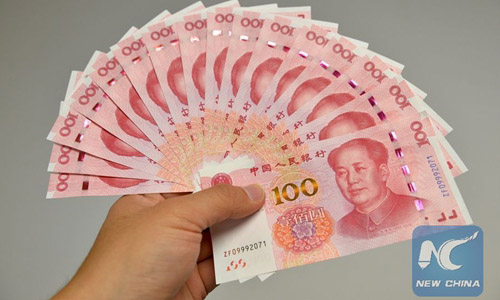China to step up bond issuance, a proactive fiscal policy to help prop up the economy

The Chengjiang Bridge is under construction in Taihe county, East China's Jiangxi Province, on October 18, 2023. Photo: VCG
As China's economy faces the last quarter of the year, how the world's second largest economy will wrap up its first year post the pandemic has been closely watched by the market.
Despite a bumpy road for Chinese economic recovery since the start of the year due to external complexity and internal challenges stemming mainly from a stagnant real estate sector and weak overall demand, industry analysts believed the economy is stabilizing and improving in particular in some sectors.
With multiple risks diffusing gradually, coupled with forceful and efficient fiscal policy and monetary policy undertaking, China's economic growth will be stabilized to a further step on a sustainable trajectory, analysts noted.
Efficiency-driven policy
China will accelerate the pace in the issuance and use of recently launched one-trillion-yuan ($139.3 billion) additional treasury bond, China's new Finance Minister Lan Fo'an said during his interview with media recently.
According to media reports, Lan made remarks on the key points of the fiscal policy in his first interview with the media, after being appointed as Party chief of the Finance Ministry in September and the minister of the ministry in October.
The Ministry of Finance will steadily promote the resolution of local government debt risk and ramp up efforts to better leverage the role of special bonds to boost the economy, Lan told the Xinhua News Agency.
The ministry will continue to carry out a proactive fiscal policy focused on improving efficiency and better giving play to effectiveness, the minister stressed.
Last month, the sixth session of the Standing Committee of the 14th National People's Congress approved the issuance of additional one trillion yuan in special treasury bonds. The funds will be used in eight specific areas, including post-disaster reconstruction, key flood prevention projects and high-standard farmland construction.
The major deployment reflected the big advantage of China's mechanism in concentrating its efforts on important tasks, which can effectively support post-disaster recovery and reconstruction, make up for the shortcomings in disaster prevention, reduction and relief capabilities, and better protect the safety of people's lives and property, Lan said.
Guan Tao, global chief economist at BOC International under Bank of China, told the Global Times that the additional bond has well reflected a proactive fiscal policy that is featured with more flexibility, while signaling the strengthening of policies to stabilize growth.
"It is undoubtedly a timely helping hand for local governments with tight financial resources as it could help drive investment in local infrastructure and reduce local hidden liabilities," Guan said.
On Monday, the Ministry of Finance published eight cases of ineffective debt dissolution by local governments, giving relevant officials warning or punishment, in a bid to resolutely curb new hidden debts and further strengthen financial discipline.
China's current macro leverage ratio for the central government stayed at 22.6 percent as of the end of the third quarter, far below the international red line of the 60 percent mark, data from the Chinese Academy of Social Sciences showed.
The expansion of fiscal policy will help stabilize the momentum of economic recovery and restore consumer confidence, Tian Yun, a veteran economist based in Beijing, told the Global Times on Monday.
Meanwhile, government spending itself plays a key role in household consumption. Therefore, the implementation of this one-trillion special bond will have a huge role in promoting the smooth circulation of the national economy, Tian noted.

Yuan Photo: Xinhua
How to properly manage and utilize the bond has been gaining market traction.In response, the finance minister said that access to the bond will be strictly controlled. Relevant agencies including the National Development and Reform Commission and the Ministry of Finance will establish a working mechanism to promptly arrange localities to complete project application and carry out project screening work.
The market widely anticipated that the sovereign bond will be issued starting from November.
The quota for issuance of the treasury bonds worth one trillion yuan will not be divided according to physical areas, but will be based on project quality and maturity, meaning the more eligible projects in a place, the greater the support they will receive from the treasury bond fund, domestic media outlet 21caijing reported Monday, citing relevant sources.
Apart from the treasury bond, Lan also confirmed that the country will frontload part of its special-purpose local government bond quota set for 2024 to reasonably ensure local financing needs.
Local government special bond is also deemed as important policy tool for expanding effective investment and stabilizing the economy.
The issuance of 3.8 trillion yuan of new special bonds this year is drawing to completion. By the end of October, about 3.67 trillion yuan of new special bonds had been issued, according to Xinhua.
Stabilizing impetus
Half of the one-trillion-yuan bond raised is planned for use this year, and the other half for next year, which means that the effects of pro-growth policies will last at least throughout the first half of 2024, and the economy's inherent growth impetus will be rejuvenated, Wang Qing, chief macroeconomic analyst at Golden Credit Rating International, told the Global Times.
Chinese officials and economists have voiced their confidence over achieving an annual economic growth target of around 5 percent this year, citing the economy's recovery momentum and gradually released effects of pro-growth policies, slapping the Western media's hype of the "crisis" theory on the world's second largest economy based on exaggeration of some weak economic indicators logged in the second quarter.
Official data released in October showed China's third-quarter growth came in much stronger than expected by registering 4.9 percent.
The fourth-quarter growth rate is widely expected to reach at least 5 percent, considering the lower comparison base of 2.9 percent in the final quarter last year.
"With pro-growth policy being gradually implemented, it is worth paying attention to in the fourth quarter whether the planned investment in new projects will show a trend of stabilization or even rebound and whether the monthly household consumption will grow strongly so that the momentum of economic recovery could be sustained," Tian said.
China's domestic consumption has contributed 83.2 percent to economic growth in first nine months of the year, becoming a major driving force, according to the National Bureau of Statistics.



